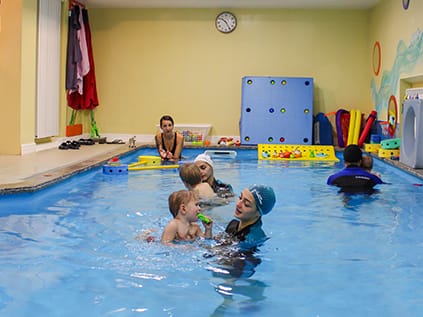Frequently asked questions

Blog ABC
Benefits of swimming, studies and examples of activities that make children friendly with water.

Salina by ABC
Saline therapy is a complementary method of prevention and treatment for respiratory diseases, with proven benefits on immunity.

Media gallery
Why take your baby to aquatic education classes?
It is recommended to start the aquatic education program before the age of 8 months when the water is more easily accepted and the swimming reflexes are still present and can be stimulated.
The baby can exercise multiple muscle groups in water than on land due to the lack of gravitational restrictions.
Why choose Acvatic Bebe Club?
ABC instructors are specialized in working with babies as young as 4 months old.
It is the only club in Bucharest that uses a mix of Ozone and UV for disinfecting the pool, with a direct effect on the quality and purity of the water, instead of the usual chlorine.
Within the club, we have a full-time nurse, who can provide support and counseling, if needed, and at the request of parents.
All Acvatic Bebe Club instructors have the first aid course completed on employment and subsequently updated annually.
Our instructors, through their professional training and personal qualities, use play as a method of teaching, so that the children can have fun while learning essential skills and abilities.
Our individual instructor-child program allows for a more personalized session based on the child’s own rhythm and disposition.
In addition to the aquatic education activity, you can register and participate in workshops with various topics for parents and children of all ages (theater, educational workshops, etc.) that take place inside the ABC Salt room.
How long does a session last?
The Super Baby membership refers to ages 4-36 months and the session is 40 minutes long, based on the child’s disposition.
The Little Scout membership refers to ages 3-6 years and the session lasts 50 minutes, based on the child’s disposition.
How many times a week should I bring my child to the pool?
Ideally 2 times a week, with at least a day in between, for the best results.
What equipment do we need?
Necessary equipment
Swimming cap
Waterproof diapers, for children under 3
Swim shorts or suits (regardless of age)
towel/robe for children who can walk on their own
Shower gel, shampoo, body lotion, cotton swabs
Equipment for accompanying adults
Swimsuit or shorts, robe, slippers, swimming cap
What is accommodation and re-accommodation in the aquatic environment?
For accommodation in an unfamiliar environment, it’s recommended that the parent joins the child in the pool. (an average of 4 sessions, and depending on the child’s reaction the instructor can ask the parent to leave)
Re-accommodation is necessary after an interruption longer than 2 consecutive weeks or after a period of discomfort based on age, the parent enters the water only for easier transfer of the child to the instructor.
The parent that joins the child in the water in the period of accommodation and re-accommodation has the role of affective support in the parent-child-instructor relationship and will listen to the instructor’s requirements.
What happens when the baby starts crying?
Usually, children respond positively to water, however, there are multiple unrelated causes for the to cry (tiredness, hunger, loud noises, abdominal cramps, swollen gums, separation anxiety, etc.) that the instructor and parent together have to identify.
It is important to keep in mind that the aquatic environment is a learning one. Beyond the motor skills they stimulate, water training requires patience, tolerance, and attention from the little ones.
Learning is not an easy process, and, like in any other process, it requires time for the abilities to start developing, which can be demanding and even frustrating, to some children. These children have a low tolerance to frustration and will start crying so that the exercise can be abandoned.
Part of the aquatic education process is increasing the level of tolerance to frustration, and our instructors are well trained to face such moments, through play-time, rest-time, giving positive stimuli to the children so that crying can be replaced with a good mood.
Empathy, patience, and good cooperation between the child, instructor, and parent are essential to overcoming these moments of frustration.
Does water inside their ears represent an infection risk?
A possible infection can occur in the outer ear only if the water left in the ear canal has not been wiped properly, which allows the bacteria to act.
The nurse or the instructors can guide you to properly clean the ear canal so that you avoid this risk.
In the case of an inner ear infection, studies have shown that this type of infection and swimming have no connection.
When does the child learn how to swim?
The first independent aquatic movements over a short distance (4-5 meters) are possible around the age of 18-24 months.
Proper swimming strokes appear around the age of 4 years.
When can I be confident enough to leave my child alone in the pool?
Never! No child is ever truly safe in or around the pool by itself, because of external factors that can disturb the child’s ability to swim.
Regardless of how well the child knows how to swim, they should always be supervised by an adult. Learning how to swim can make them safer, but never completely.
Is there a difference between starting the courses during winter as opposed to summer?
It is important that weather conditions do not affect when you start the program. Changes in temperature and climatic factors can actually contribute significantly to strengthening the immune system.
Swimming is the only activity where children and socialize and develop their motor skills during the cold season, without the risk of getting sick, being in a safe environment under the strict supervision and guidance of specialized and experienced staff.
How do you acclimatize during the cold season?
To promote continuity of activity in the pool and strengthen the immune system:
We recommend reaching the pool 10-15 minutes before the start of the lesson, taking off their thick clothes at the entrance of the club, for better acclimatization with the atmosphere inside.
Giving the child a shower with a temperature comfortable to their skin, not hot, before and after the session.
The baby is transported from the pool to the dressing room in a bathrobe or towel.
Showering before getting inside the pool has an acclimatization role, it has to be done right before the session starts and you should not wipe their skin dry.
Once the session is over, shower the child again with a temperature comfortable to their skin. Making sure you wipe the outer ear properly and dry their hair.
Clothing the child gradually, thicker clothes at the exit of the club, after the acclimatization break, of at least 15 minutes between shower and departure.
Why is continuity important during an aquatic education program?
Children can easily forget all the skills they have acquired after a long break because they do not have muscle memory.
Positive results and skill learning are more evident and last longer under a constant program.
The acclimatization process and our ABC teaching method are used regardless of the season.
Why does my child react negatively when we take him to a different pool?
Although he is used to the water, the child needs time and support to accommodate to a new surrounding.
His mood can be affected by external factors such as temperature, ambiance, strangers, failure to keep his own pace, etc.
Can I exercise what he was taught with him in our free time?
This should be done only at the advice and methodical instructions of the instructor who works with the child.
Do you offer the possibility to recover absent sessions?
Yes, we do if: the absence is announced 24 hours minimum before the session was scheduled or if there is a medical condition in which case we will need a doctor’s slip within 7 days of returning to the program.
What does the subscription validity period mean?
The validity period is defined by the number of weeks included in the membership.
Thus, the monthly membership includes 4 available weeks, trimestrial has 12, semestrial 24, the annual 48. In the case of 2 entries per week, the validity is identical, only the grace period differs, which is doubled, compared to the standard grace period, for the subscription with one entry per week.
What is the grace period?
The grace period depends on the type of membership acquired (the larger it is more sessions are included) and it’s the period when absent sessions can be recovered. During this time we can schedule multiple sessions a week (regardless of the type of subscription) depending on ours and your availability.

